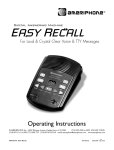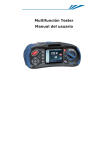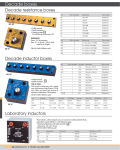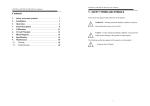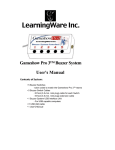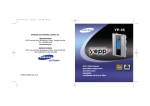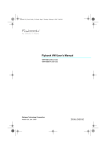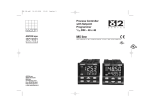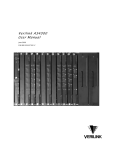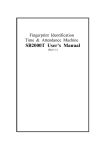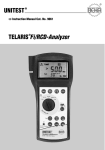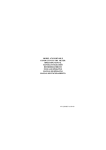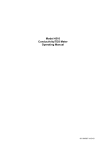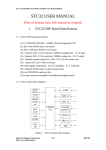Download - AD INSTRUMENTS
Transcript
$',167580(176 $'Multifunction Tester User Manual Multifunction Tester User Manual Multifunction Tester User Manual Contents Page 1-Safety Considerations ......................................................................... 4 1. 1.1-International Symbols .................................................................... 4 1. 1.2-Terminology................................................................................. 4 1. 1.3-Warnings ..................................................................................... 4 1. 1.4-Caution ........................................................................................ 5 1. 1.5-Declaration of Conformity............................................................... 5 1. 1.6-Error Codes .................................................................................. 5 2-Specification ...................................................................................... 5 3-General Specification .......................................................................... 8 4-Instrument Overview........................................................................... 8 4. 4.1-Front View.................................................................................... 8 4. 4.2-Connector Panel ............................................................................9 4. 4.3-Battery & Fuse .............................................................................. 9 4. 4.4-Understanding the Display...............................................................10 5-How to Use the Tester......................................................................... 13 4. 5.1-Impor tant Symbols and Messages during the measurement .................13 4. 5.2-Using the LOOP/PFC Function ........................................................ 15 6-Using the Insulation Function ................................................................ 27 4. 6.1-Insulation Function/Menu Operation ................................................. 27 4. 6.2-Insulation Resistance Display/Switch and Terminal Settings ................ 28 4. 6.3-Using the RE Function .................................................................... 28 4. 6.4-Ear th Resistance Display/Switch and Terminal Settings ...................... 29 4. 6.5-To Measure Ear th Resistance .......................................................... 29 4. 6.6-RE Function Menu Operation ........................................................... 29 4. 6.7-Using the LOW OHM Function .......................................................... 29 4. 6.8-LOW OHM Function Menu Operation ................................................. 30 7-Menu ................................................................................................ 31 8-System Settings ................................................................................. 31 4. 8.1-Languages ................................................................................... 31 4. 8.2-Date/Time .................................................................................... 32 4. 8.3-TV............................................................................................... 32 4. 8.4-Memory....................................................................................... 32 4. 8.5-Auto Screen-off.............................................................................33 4. 8.6-Auto Power-off.............................................................................. 33 4. 8.7-System Default Settings ..................................................................33 4. 8.8-System Upgrade ............................................................................34 9-Run Settings ...................................................................................... 34 4. 9.1-Bluetooth ..................................................................................... 34 4. 9.2-Data Record ................................................................................. 35 4. 9.3-Datalog ....................................................................................... 35 10-Data Record ..................................................................................... 35 10- 10.1-Delete Files .............................................................................. 36 10- 10.2-Data Record Preview.................................................................. 36 10- 10.3-Menu ....................................................................................... 37 10- 10.4- Drawing ................................................................................. 38 10- 10.5-Datalog Color........................................................................... 39 3 Multifunction Tester User Manual Warning! You must read and completely understand the Safety Considerations part of this manual before using the instrument. 1-Safety Considerations This manual contains instructions regarding the safe use and the proper functioning of the instrument. If not complied with, the user could be exposed to danger and the instrument to possible damage. 1.1-International Symbols WARNING! CAUTION! Voltage present Earth Double Insulation (Class II insulation) Fuse >550V Prohibited to use for the Electrical System which uses the voltage above 550V Conformity to European Standards 1.2-Terminology The term WARNING as used in this manual defines a condition or a procedure which could lead to a serious injury or accident. The term CAUTION defines a condition or action which could lead to the instrument being rendered defective during the testing process. 1.3-Warnings • Make sure to read and fully understand the instruction contained within this manual prior to use. • This instrument is not intrinsically safe therefore do not use the instrument in hazardous environments. • In order to prevent fire and/or electrical shock, do not use the instrument in wet, damp or highly humid • environments. • Prior to use, check if the instrument functions correctly. If any symptoms/symbols of malfunction or abnormalities • are indicated, do not use and inform MTi Instruments. • Users who could be exposed to voltages in excess of the extra low band (50V ac or 120V dc) should be • competent and be aware of the requirements of GS 38 regarding the use of the instrument and the associated • leads and probes etc. • Make sure your fingers holding the test probes are positioned behind the safety lines of the test probes. • DO NOT OPEN THE INSTRUMENT. • If the internal fuse (protective device) operates, replace with a device of the same type and rating. If it operates • again seek professional advice. DO NOT REPLACE FUSE AND TRY AGAIN. • When carrying out the “dead tests” ensure prior to connection of the instrument leads the circuit under test • has been confirmed “dead” and secured in the OFF position using appropriate methods. • Battery condition is indicated by a beep. Check and replace if necessary. • Do not test an electrical circuit or systems where the voltage is in excess of 550V. • Ensure at all times the leads are in compliance with GS 38 (as supplied) and not damaged. 4 Multifunction Tester User Manual 1.4-Caution Do not change functions on the test instrument with the test leads in place, i.e. changing from a “dead test” to a test where the supply is required could damage the instrument. 1.5-Declaration of Conformity This instrument has been tested according to the below regulations: EN 61326: Electrical equipment for measurement, control and laboratory use. EN 61010-1: Safety requirements for electrical equipment for measurement, control and laboratory use –Part 1: General requirements. BS EN61557: Electrical safety in low voltage distribution systems up to 1000V a.c. and 1500V d.c. Equipment for testing, measuring or monitoring of protective measures. • Part 1 General requirements • Part 2 Insulation resistance • Part 3 Loop resistance • Part 4 Resistance of earth connection and equipotential bonding • Part 6 Residual current devices (RCDs) in TT and TN systems • Part 7 Phase sequence • Part 10 Combined measuring equipment 1.6-Error Codes Various error conditions are detected by the tester and are indicated with the icon, “Err”, and an error number on the primary display. See Table 1. These error conditions disable testing and, if necessary, stop a running test. Table 1. Error Codes Error Condition Code Code Solution 1 Fault Voltage Over Temp 2 Excessive Noise 3 Excessive Probe Resistance 4 Self Test Fails 5 Solution Check the installation, in particular, the voltage between N and PE. Wait while the tester cools down. Switch off all appliances (Loop, RCD measurements) and move the earth stakes (earth measurement). Put the stakes deeper into the soil. Tamp down the soil directly around the stakes. Pour water around the stakes but not at the earth ground under test. Return the tester to a Service Center. 2-Specification LOOP Resistance L- PE (Hi-Amp) Range(Ω) 0.23~9.99 10.0~99.9 100~999 Resolution(Ω) 0.01 0.1 1 Accuracy ±(4% of reading+6digits) Measuring Current: 8.0 A~25.0 A Range of the Voltage Used: 195V a.c. – 260V a.c. (50,60Hz) 5 Multifunction Tester User Manual Notes [1] Valid for resistance of neutral circuit <20Ω and up to a system phase angle of 30°. Test leads must be [1] zeroed before testing. [2] Valid for mains voltage >200V. L- PE (No Trip) Range(Ω) 0.23~9.99 10.0~99.9 100~999 Resolution(Ω) 0.01 0.1 1 Accuracy ±(5% of reading+6 digits) Measuring Current: < 15mA Range of the Voltage Used: 195V a.c – 260V a.c (50,60Hz)(50,60Hz) Notes [1] Valid for resistance of neutral circuit <20Ω and up to a system phase angle of 30°. Test leads must be [1] zeroed before testing. [2] Valid for mains voltage >200V. LINE Resistance L- N Range(Ω) 0.23 – 9.99 10.0 – 99.9 100 – 999 Resolution(Ω) 0.01 0.1 1 Accuracy ±(4% of reading+4digits) Measuring Current: 4.0 A Range of the Voltage Used: 195V a.c. – 260V a.c. (50,60Hz) Notes [1] Valid for resistance of neutral circuit <20Ω and up to a system phase angle of 30°. Test leads must be [1] zeroed before testing. [2] Valid for mains voltage >200V. RCD (BSEN 61557-6) Rcd Rating (I_n): 10mA, 30mA, 100mA, 300mA, 500mA, 650mA and 1A. Test current: x1/2, x1, x2 and x5 Accuracy at applied test current Current Multiplier Trip Time Accuracy ±(1% of reading+1ms) x1/2 ±(1% of reading+1ms) x1 ±(1% of reading+1ms) x2 ±(1% of reading+1ms) X5 Form of the Test Current: Sine wave form (ac), Pulse wave form (dc) RCD Form: General (G - non-delayed), Selective (S - time-delayed) Initial Polarity of the Test Current: 0°, 180°. Voltage Range: 195V a.c. - 260V a.c. (50Hz,60Hz) 6 Multifunction Tester User Manual Accuracy of the Current of the RCD: ± (5% of reading + 1digits) Resolution of the RCD Timing: 0.1ms Voltage and Frequency Measurement Range Resolution(V) (V)/AC-DC 80~500 1 Accuracy Measurement Range Resolution(Hz) (Hz) 45~65 1 Accuracy Insulation Terminal Voltage Range Resolution 0.001Ω 0.01Ω 0.1Ω 1Ω Earth Resistance Range Resolution 0.00~99.99Ω 0.01Ω 100.0~999.9Ω 0.1Ω 1000~2000Ω 1Ω ±2Hz Resolution Accuracy 125V(0%~+10%) 0.125~4.000 MΩ 4.001~40.00 MΩ 40.01~400.0 MΩ 400.1~1000 MΩ 250V(0%~+10%) 0.250~4.000 MΩ 4.001~40.00 MΩ 40.01~400.0 MΩ 400.1~1000 MΩ 500V(0%~+10%) 0.500~4.000 MΩ 4.001~40.00 MΩ 40.01~400.0 MΩ 400.1~1000 MΩ 1000V(0%~+10%) 1.000~4.000 MΩ 4.001~40.00 MΩ 40.01~400.0 MΩ 400.1~1000 MΩ Low Ohm Range 0.000~2.000Ω 2.00~20.00Ω 20.0~200.0Ω 200~2000Ω ±(2% of reading +2digits) 0.001MΩ 0.01MΩ 0.1MΩ 1MΩ 0.001MΩ 0.01MΩ 0.1MΩ 1MΩ 0.001MΩ 0.01MΩ 0.1MΩ 1MΩ 0.001MΩ 0.01MΩ 0.1MΩ 1MΩ Test Current Short circuit current ±(3%+10) 1mA @load125kΩ ≤1mA ±(2%+10) ±(4%+5) ±(5%+5) ±(3%+10) 1mA @load250kΩ ≤1mA ±(2%+10) ±(3%+2) ±(3%+2) ±(3%+10) 1mA @load500kΩ ≤1mA ±(2%+10) ±(3%+2) ±(4%+5) ±(3%+10) 1mA @load1MΩ ≤1mA ±(2%+10) ±(3%+2) ±(4%+5) Accuracy Max. Open Circuit Voltage Overload Protection ±(1.5%+30) 5.0V±1VDC 250Vrms ±(1.5%+3) ±(1.5%+5) Accuracy ±(2%+30d) ±(2%+6d) 7 Multifunction Tester User Manual 3-General Specification Power Source Battery Life CAT Rating Protection Classification Protection Rating LCD Screen Type Pixels Operating Temp Relative Humidity Storing Temp Operating Altitude Protective device Dimensions Weight 8 x 1.5V AA Size Alkaline batteries or 8 x 1.2V AA Size rechargeable Ni-MH batteries Average of 15hours CAT III 600V Double Insulation I 3.5”TFT 320x240 0°C~ 45°C 95% 10°C~ 30°C: Non-condensing 75% 30°C~ 40°C -10°C~ 60°C 2000m 500mA Fast response BS 88 Fuse 24.2cm(L) x 10.5cm(W) x 14.5cm(H) 1.56kg 4-Instrument Overview 4.1-Front View 1-Starts the selected test. The T key is surrounded by a “touch pad”. The touch pad measures the potential 1- between the operator and the tester’s PE terminal. If you exceed a 100 V threshold, the D symbol above 1- the touch pad is illuminated. 2-Warning lamp 3-320X(RGB)X240 color active matrix 4-Press and hold Turns the tester on and off. Short Press return the latest status. 5-Function selector switch. 6-Navigation keys: 6-Enter, Up, Down, Left/Save, Right 7-Selects the sub-menus from the Test Mode selected by the rotary switch: 7-F1, F2, F3, F4 8-Accesses help menus and delete files . 1 5 6 2 8 7 3 8 Multifunction Tester User Manual 4.2-Connector Panel 1-Input Terminal to operate the switched probe 2-L - Line Input 3-PE - Protective Earth Input 4-N - Neutral Input 5-Input Terminal to operate the switched probe 6-TV OUT 7-System Reset 8-USB Connector 9-Power Supply Socket 2 1 3 4 PE L 5 N L1 L2 L3 VΩ MΩ CAT III 600V RESET TV OUT 15V DC 1.0A 9 6 7 8 4.3-Battery & Fuse 1-Fuse 5A 600V 2-Fuse 5A 600V 3-Fuse 500mA 600V 4-Battery cells (size AA). 1 2 3 0V mA 60 F500 0≥ A H 60 ≥50KA 50KA F5 F5A H 600V ≥50KA 4 9 Multifunction Tester User Manual 4.4-Understanding the Display 5 28 12 13 11 10 9 8 6 1 27 2 26 7 14 15 16 3 17 18 19 20 4 25 24 23 22 21 No. Annunctator Function RCD 1 Value TA RCD TIME T RCD TIME N RCD TRIP Loop/PFC V/Phase Continuity 10 L-PE L-L L-N L-PE 0.5Ω 1.0Ω 2.0Ω 5.0Ω AUTO X1/2 X1 X2 X5 RAMP Multifunction Tester User Manual No. Annunctator Function 1 Continuity Terminal Voltage 2 Trip Current Current Beeper 3 10.0Ω 20.0Ω 50.0Ω 50.0Ω 125V 250V 500V 1000V 30mA 100mA 300mA 500mA 650mA 1000mA 10mA NO Trip Hi Amp OFF ON Type of RCD G S G S Lock 4 0°/180° ZERO Reference 5 OFF ON 0° 180° 0 0.125MΩ 0.25MΩ 0.5MΩ 1MΩ 2MΩ 5MΩ 10MΩ 20MΩ 50MΩ 100MΩ 200MΩ Date Time 11 Multifunction Tester User Manual Meaning Low battery icon. See No. Annunctator 6 :Indicates the battery status. :100% :80% :50% :20% :Low Battery 7 8 9 10 11 12 13 14 15 16 17 18 19 20 21 for additional information on batteries and power management. Beeper Lock Hold Datalog Bluetooth Appears when the instrument is overheated. Display 30 seconds (time-delayed) Being tested Primary display and measurement units. 30S 888.8 Ω Primary display and measurement units. 888.8 U F: U L: L PE L PE N L PE N L1 L2 L3 L 230 PE N 1 Fault voltage. Measures neutral to earth. Indicates the preset falut voltage limit. Arrows above or below the terminal indicator symbol indicate reversed polarity. Check the connection or check the wiring to correct. N 231 L 230 PE 1 N 231 26 N-PE Value L-N Value L-PE Value Prospective Earth Fault Current. Calculated from voltage and loop impedance which is measured line to protective earth. Prospective Short Circuit. Calculated from measured voltage and impedance when reading line to neutral. Being tested 27 28 High Voltage Warning Warning 22 23 24 25 N-PE L-N L-PE PFC PSC 12 Multifunction Tester User Manual 5-How to Use the Tester 5.1-Important Symbols and Messages during the measurement 1 5 2 3 4 2 Figure 1 Screen 5.1Description 5.11-Battery status 5.12-Displayed measured value 5.13-The measurement unit of the measured value 5.14-The indication of the correct input terminal connection 5.15-Displayed menu 5.1.1-Displayed icons (symbols) and messages in VOLTAGE function :Indicates the correct input terminal connectivity . The user should connect the test leads to the appropriate terminals. :Indicates L connection is connected on the N input terminal and vice-versa :Indicates no connection on the PE input terminal If the wiring condition is other than normal, the Tester is limited on its measurements that can be performed. Notes: • Will not detect two hot wires in a circuit. • Will not detect a combination of defects. • Will not detect reversal of grounded and grounding conductors. :Indicates the battery status. :100% :80% :50% :20% :Low Battery 13 Multifunction Tester User Manual 5.1.2-Displayed icons (symbols) and messages in LOOP/PFC function :Indicates the correct input terminal connectivity . The user should connect the test leads to the appropriate terminals. :Indicates L connection is connected on the N input terminal and vice-versa :Indicates no connection on the PE input terminal If the wiring condition is other than normal, the Tester is limited on its measurements that can be performed. Notes: • Will not detect two hot wires in a circuit. • Will not detect a combination of defects. • Will not detect reversal of grounded and grounding conductors. :Indicates the battery status. :100% :80% :50% :20% :Low Battery :Indicates high temperature and therefore cannot make any measurements Message: Measuring : Function in use - measurement being carried out RCD Trip: During the measurement, the RCD has tripped therefore no test result obtained -Noise-: Appears during the No Trip Loop Measurement, and indicates that the displayed value may not be -Noise-: accurate due to “mains” interference - test to be repeated 5.1.3-Displayed icons (symbols) and messages in RCD function : Indicates the correct input terminal connectivity . The user should connect the test leads to the appropriate terminals. : Indicates L connection is connected on the N input terminal and vice-versa : Indicates no connection on the PE input terminal If the wiring condition is other than normal, the Tester is limited on its measurements that can be performed. Notes: • Will not detect two hot wires in a circuit. • Will not detect a combination of defects. • Will not detect reversal of grounded and grounding conductors. : Indicates the battery status. : 100% : 80% : 50% : 20% 14 Multifunction Tester User Manual : Low Battery : Indicates high temperature and therefore cannot make any measurements Message: Half: Appears during the auto test when rcd has operated on the x ½ test Half Trip: Appears during the manual test when rcd has operated on the x ½ test UL OVER: Appears when UF voltage exceeds the previously set UL voltage. (UL voltage can be set to 25V UL OVER: or 50V) The user must check the impedance between L-PE 5.1.4-Displayed icons (symbols) and messages when using the LOW OHM and CONTINUITY functions Symbol: : Indicates correct input terminal connectivity. The user should connectthe test leads to : the appropriate terminals indicated by color coding. : Low Battery (The icon will be flashing along with the beep sound). : The resistance of the test leads are included in the test measurement : The resistance of the test leads are not included in the test measurement 5.1.5-Displayed icons (symbols) and messages when using the RE functions : Indicates correct input terminal connectivity. The user should connect the test leads to : the appropriate terminals indicated by color coding. : Low Battery (The icon will be flashing along with the beep sound). : The resistance of the test leads are included in the test measurement : The resistance of the test leads are not included in the test measurement 5.1.6-Displayed icons(symbols) and messages in INSULATION function : Indicates correct input terminal connectivity. The user should connect the test leads to : the appropriate terminals indicated by color coding. : Low Battery (The icon will be flashing along with the beep sound). : Indicates high voltage (125V, 250V,500V or 1000V) at probe terminals, Use caution 5.2-Using the LOOP/PFC Function 1-Before you do a loop impedance test, use the zero adapter to zero the test leads or the mains cord. Press annunciator appears. The tester measures 1-and hold F4 button for more than two seconds until the 1-the lead resistance, stores the reading in memory, and subtracts it from readings. The resistance value is 1-saved even when the power is turned off so it is unnecessary to repeat the operation each time you use the 1-tester with the same test leads or mains cord. Note: Be sure the batteries are in good charge condition before you zero the test leads. 2-You can select UL Voltage by Pressing and hold F3 button for more than two seconds (25V or 50V). 15 Multifunction Tester User Manual 5.2.1-Using the No Trip LOOP Measurement to be selected where the circuit is protected by an RCD whose rating is 30mA or above 1-Turn the rotary switch to the LOOP/PFC position 2-Connect the test leads as Figure Figure 4 3-If voltage of the L- PE on the lower left appears, the 1-unit is ready to TEST 4-Press the TEST button when ready 5-If NOISE appears during the No Trip Loop 3-Measurement, the displayed value may not be 3-accurate due to “mains” interference and the 3-test should be repeated Ω A Figure 3-No Trip LOOP When carrying out the test from a 13A socket the points of contact are automatically selected by the plug top connection 16 Multifunction Tester User Manual 5.2.2-LOOP / PFC Function Menu Operation Main Display Menu Display F1 Button: Pop-up and shutdown Loop/PFC menu , Shutdown mode is activated when the user selects. F2 Button: Pop-up and shutdown Current menu , Shutdown mode is activated when the user selects F3 Button: None F4 Button: Press the F4 button 3S, triggering zero function. Up Button: Up menu to select the current active sub-options. Down Button: Down menu to select the current active sub-options. Enter Button: Confirm the user select mode. 17 Multifunction Tester User Manual 1-When measuring is completed, impedance of 1-L- PE and PFC (lf) value appears on the screen 2-Press TEST button if re-test is necessary. , , 1-When symbol from 1- appears lower left corner, and if the voltage 1-exceeds 260V, the measurement will not take place 5.2.3-Using the Hi Amp LOOP Measurement to be selected where the circuit is NOT protected by the inclusion of an RCD 1-Turn the rotary switch to the LOOP / PFC position 2-Press F2 button to change from No Trip to Hi Amp 3-Connect the test leads as shown in the Figure 8 4-If voltage of the L- PE on the lower left appears, the 1-unit is ready to TEST 5-Press the TEST button when ready 18 Multifunction Tester User Manual 6-When the measuring is complete the impedance 5-of L-PE and PFC (lf) value appears on the screen 7-Press TEST button if re-test is necessary , , 6-When symbol from 6- appears lower left corner, and if the voltage 6-exceeds 260V, the measurement will not take 6-place 0.41 Current Hi Amp A PE L 230 N 1 UL :25V 231 5.2.4-Using the L- N Line Impedance Measurement 1-Turn the rotary switch to the LOOP / Psc position 2-Press F1 button to change from L - PE to L - N 3-Connect the test leads as shown in Figure 12 4-If voltage of the L- PE on the lower left appears, the 1-unit is ready to TEST 5-Press the TEST button when ready L PE 19 Multifunction Tester User Manual 6-When measuring is completed, impedance of 6-L - N and PSC value appears on the screen 7-Press TEST button if re-test is necessary When symbol from , , appears lower left corner, and if the 66-voltage exceeds 260V, the measurement will 6-not take place PSC 5.2.5-Using The RCD Function You can select UL Voltage by Pressing and hold F3 button for more than two seconds (25V or 50V). Uf value appears is the contact voltage on the screen. 20 Multifunction Tester User Manual Function Button Description BUTTON 1 2 AUTO RCD tΔ F1 30mA 100mA F2 AC G AC S F3 0 F4 180 3 4 5 RCD IΔN 300mA 500mA 650mA DC G DC S 6 7 1A 10mA G: General (non-delayed) RCDs S: Selective (time-delayed) RCDs Possible setup ratios depending on the RCD Trip Current X X1/2 X1 X2 X5 AUTO RAMP 10mA O O O O O O 30mA O O O O O O 100mA O O O O O O 300mA O O O X X O 500mA O O O X X O 650mA O O X X X O 1A O O X X X X Maximum measurement Trip Time of the RCD (Complying to BS 61008 and 61009) ½XIΔN V 2xIΔN 5xIΔN IΔN tΔ= General tΔ= tΔ= Max.40mS tΔ= (non-delayed) Max.1999mS Max.500mS Max.150mS RCD tΔ= Selective tΔ= tΔ= Max.40mS tΔ= (time-delayed) Max.1999mS Max.500mS Max.150mS RCDs IΔN: Trip-Out Current tΔ: Trip-Out Time : Indicates that the thermal protection device has operated and therefore cannot make any measurements. Instrument must be allowed to cool for a period before tests can continue. 21 Multifunction Tester User Manual Using the Functions activated by F1 button Using the AUTO Mode 1-Turn the rotary switch to the RCD position 2-Initial screen is setup to the AUTO 3-Using the F2 and F3 button, select the rating and 1-the type of the RCD 4-Connect test leads as shown in the Figure 15 5-If --- from the lower right corner disappears and 1-voltage of the L- PE on the lower left appears, the 1-unit is ready to TEST (If N and PE test leads are 1-reversed, the instrument will still carry out the test) 6-Press the TEST button when ready 7-Test will proceed it should not trip from x ½ mode 1-but will trip from the x 1 0° mode, and indicate 1-the trip time 8-Reset RCD the unit will measure the Trip Time 1-from the x 1 180° mode 9-Repeat for both x 5 0° and x 5 180° resetting 1-RCD after each test 10-Tests now complete - see display for results 22 Multifunction Tester User Manual 01.01.2013 00:32 Using the x1/2, x1 and x5 manual selection RCD 1-Turn the rotary switch to the RCD position X1 2-Press F1 and aspect button from the AUTO to Trip 2-select x1/2, x1 and x5 3-Using the F2 and F3 button, select the RCD’s trip 30mA 2-current and type of the RCD. (General/Selective) Type— 4-Connect the test leads as shown in Figure 15 5-If --- from the lower right corner disappears and G 2-voltage of the L- PE on the lower left appears, the 0°/180° 2-unit is ready to TEST L PE N U F : 1.2V 0° 2-(If N and PE test leads are reversed, the instrument U L: 25V 2-will still carry out the test) Figure 17 x1 Mode-Measuring screen 6-Using the Selective RCDs with F3 button S : Selective (time-delayed) RCDs S (Selective (time-delayed)) RCDs will measure by delaying 30 seconds and then stream the current. 2-(will display 30 seconds during the time of the delay) AC RCD streams current in r.m.s. value which has the sine wave form. DC RCD streams current in r.m.s. value which has the pulse wave form. 7-Using the Selective 0°and 180° with F4 button 8-Press the TEST button when ready 9-Record slowest time 19.5 Using the RAMP Function 1-Turn the rotary switch to the RCD position 2-By pushing the F1 button select RAMP from AUTO 3-Using the F2 and F3 button, select the RCD’s trip 2-current and type of the RCD 4-Using the Selective 0°and 180° with F4 button 5-Press test button-the test current “ramps up from 2-3mA to 33mA in 3mA stages 6-The RCD should operate approximately 21mA for 2-it to be in Compliance RCD 01.01.2013 00:35 RAMP 21 Trip 30mA Type--G 0°/180° 0° L PE N U F : 1.2V U L: 25V Figure 18 RCD Ramp-Measuring screen 23 Multifunction Tester User Manual 5.2.6-RCD Function Menu Operation Main Display RCD AUTO Other 00:45 Menu Display F1 Button: Pop-up and shutdown RCD menu , Shutdown mode is activated when the user selects. F2 Button: Pop-up and shutdown Trip Current menu , Shutdown mode is activated when the user selects F3 Button: Pop-up and shutdown Type of RCD menu , Shutdown mode is activated when the user selects F4 Button: Pop-up and shutdown Type of 0°/180° menu , Shutdown mode is activated when the user selects Up Button: Up menu to select the current active sub-options. Down Button: Down menu to select the current active sub-options. Enter Button: Confirm the user select mode. 24 Multifunction Tester User Manual 5.2.7-Using the VOLTAGE Function WARNING! Do not use on a circuit whose voltage either L-L or L-N exceeds 550V Measuring the Voltage and Frequency Figuire 19 Standby screen for the Voltage and Frequency 1-Connect the test lead input terminal 2-Turn the rotary switch to the VOLTAGE position Do not attempt to measure when the input voltage is above 500V a.c. Value at the top right hand corner represents the Voltage, and the value in the right hand center represents the frequency. The display will appear without the TEST button operated. Figure 20 Screen while measuring Voltage and Frequency 5.2.8-Using the Phase Sequence Function Determining the Phase Sequence 1-Turn the rotary switch to the VOLTAGE position 2-Press F1 to make symbol is displayed 3-Connect the test leads L1, L2, L3 as shown on 2-the Figure 22 4-When the instrument is energized the sequence 2-will be displayed automatically Figure 21 Initial screen of the Phase Sequence Measurement 25 Multifunction Tester User Manual L N PE TEST F1 F2 ESC F3 F4 LOO Pfc P V RCD LOW OHM RE HELP INSU LATIO N Bluetooth Figure 22 Phase Sequence-Test lead connection When the line conductors are connected in the correct sequence 1.2.3 and the symbol will appear as the Figure 23 However, connected in the wrong sequence, 2.1.3 and the circle symbol will change to the symbol displayed below Figure 23 Phase Sequence screen-when connected in clockwise direction. Figure 24 Phase Sequence-When connected in counter-clockwise manner 26 Multifunction Tester User Manual 5.2.9-Voltage/Phase Function Menu Operation Main Display Menu Display F1 Button: Pop-up and shutdown Voltage/Phase menu , Shutdown mode is activated when the user selects. F2 Button: None F3 Button: None F4 Button: None Up Button: Up menu to select the current active sub-options. Down Button: Down menu to select the current active sub-options. Enter Button: Confirm the user select mode. 6-Using the Insulation Function Termi... 125V Beeper OFF Lock ON Reference 0.125M 6.1-Insulation Function/Menu Operation Main Display Termi... 125V Beeper OFF Lock OFF Reference 0.125M 27 Multifunction Tester User Manual Menu Display Termi... 125V Termi... 125V Termi... 125V Beeper OFF Beeper OFF Beeper OFF Lock OFF Lock OFF Lock OFF Reference Reference Reference 0.125M 0.125M 0.125M F1 Button: Pop-up and shutdown Insulation menu , Shutdown mode is activated when the user selects. F2 Button: Pop-up and shutdown Insulation menu , Shutdown mode is activated when the user selects. F3 Button: Pop-up and shutdown Insulation menu , Shutdown mode is activated when the user selects. F4 Button: Pop-up and shutdown Insulation menu , Shutdown mode is activated when the user selects. Up Button: Up menu to select the current active sub-options. Down Button: Down menu to select the current active sub-options. Enter Button: Confirm the user select mode. 6.2-Insulation Resistance Display/Switch and Terminal Settings WARNING! 6.2-Measurements should only be performed on de-energized circuits. 6.2-To measure insulation resistance 1-Turn the rotary switch to the INSULATION position. 2-Use the L and N (red and black) terminals for this test. 3-Press F4 and set limit value (optional). 4-Use the F1 to select the test voltage. Most insulation testing is performed at 500 V, but observe local test 3-requirements. 5-Press and hold TEST button until the reading settles and the tester beeps. Note Testing is inhibited if voltage is detected in the line. The primary (upper) display shows the insulation resistance. The secondary (lower) display shows the actual test voltage. Note For normal insulation with high resistance, the actual test voltage (UN) should always be equal to or higher than the programmed voltage. If insulation resistance is bad, the test voltage is automatically reduced to limit the test current to safe ranges. 6.3-Using the RE Function 28 Multifunction Tester User Manual 6.4-Earth Resistance Display/Switch and Terminal Settings The earth resistance test is a 3-wire test consisting of two test stakes and the earth electrode under test. This test requires an accessory stake kit. Connect as shown in right figure . Best accuracy is achieved with the middle stake at 62 % of the distance to the far stake. The stakes should be in a straight line and wires separated to avoid mutual coupling. The earth electrode under test should be disconnected from the electrical system when conducting the test. Earth resistance testing should not be performed on a live system. 6.5-To Measure Earth Resistance 1-Turn the rotary switch to the RE position. 2-Press and release TEST button. Wait for the test to complete. The primary (upper) display shows the eart resistance reading. The Test Current will be displayed in the secondary display. If Voltage detected between the test rods greater than 10V, the test is inhibited. 6.6-RE Function Menu Operation Main Display F1 Button: None F2 Button: None F3 Button: None F4 Button: Short the F4 button 3S, triggering zero function. Up Button: None Down Button: None Enter Button: None 6.7-Using the LOW OHM Function 29 Multifunction Tester User Manual A continuity test is used to verify the integrity of connections by making a high resolution resistance measurement. This is especially important for checking Protective Earth connections. 6.8-LOW OHM Function Menu Operation Main Display Menu Display F1 Button: Pop-up and shutdown LOW OHM menu , Shutdown mode is activated when the user selects. F2 Button: Pop-up and shutdown LOW OHM menu , Shutdown mode is activated when the user selects. F3 Button: None F4 Button: Short the F4 button 3S, triggering zero function. Up Button: Up menu to select the current active sub-options. Down Button: Down menu to select the current active sub-options. Enter Button: Confirm the user select mode. 30 Multifunction Tester User Manual 7-Menu Items Menu System Settings Data Record Run Settings Press the and button to enter. button to select the System Settings, Data Record or Run Settings. Then press the 8-System Settings Items Menu Languages Date/Time TV Memory Auto screen-off Auto power-off System default settings System upgrade Press the and button to select the Items, Then press the button to enter 8.1-Languages Press the and button to select the language, press ESC button to esc and save the select the language. 31 Multifunction Tester User Manual 8.2-Date/Time Press the and button to select the date or time, Then press the button to enter, Press the and button to adjust the value, Press the and button to select the Items ,press the ESC button to esc and save. 8.3-TV Press the and button to select the output time, Then press the button to enter. 8.4-Memory Press the and button to select the Working Space or Format , Then press the button to enter, press the ESC button to esc and save. 32 Multifunction Tester User Manual 8.5-Auto Screen-off Default 3 Minutes, Press the and button to select the Auto screen-off time, press ESC button to esc and save the select the time. 8.6-Auto Power-off Default 10 Minutes, Press the and button to select the Auto power-off time, press ESC button to esc and save the select the time. 8.7-System Default Settings Then press the button to enter, Then press the and button to select whether Reset. 33 Multifunction Tester User Manual 8.8-System Upgrade Then press the button to enter. 9-Run Settings Items Menu On or off the Bluetooth Data Record Datalog Press the and button to select the Items, then press the button to enter. 9.1-Bluetooth Off the Bluetooth On the Bluetooth Press the 34 and button to select the on or off bluetooth , press the ESC button to esc and save. Multifunction Tester User Manual 9.2-Data Record Menu Items F1 button Backspa F2 button Enter Data Record Enter characters Press the button to select the characters , press the button to Enter characters. NOTE: Data recording shortcuts, press the left button. 9.3-Datalog Menu Items On or off the Datalog / / Set Datalog time(Unit : second) Press the and button to select the Items, Pressthe and button to set. 10-Data Record Press the and button to select the data record file, press button to to enter. 35 Multifunction Tester User Manual 10.1-Delete Files Press Help/Delete button to menu, Press the and button to select the Yes or No , press button to execute. 10.2-Data Record Preview Main Display ~ F1 Button: None F2 Button: None F3 Button: None F4 Button: None Up Button: Turned up view log data Down Button: Turned down view log data Left Button Right Button Enter Button: Menu Press the and button to select the view log data, Press the and button to select the files ,press button to menu, press the ESC button to esc data record preview. 36 Multifunction Tester User Manual 10.3-Menu 10.3.1-Data record 10.3.2-Datalog Settings Menu Display F1 Button: None F2 Button: None F3 Button: None F4 Button: None Up Button: Select up Down Button: Select down Left Button: None Right Button: None Enter Button: Confirm the user select mode Press the and button to select the Items, Then press the button to enter 10.3.3-Bluetooth 37 Multifunction Tester User Manual 10.4-Drawing 4 3 1 2 5 6 13 12 7 8 9 10 11 No. Annunctator File Name 1 Meaning File named: Month/day File type LOOP PFC LOG 01-01 00-03-13.txt Function Hours/minutes/seconds 2 3 4 5 6 7 8 9 10 11 12 13 38 Primary display and measurement units. Primary display and measurement units. Coordinate Function Function hours/minutes/seconds Record time L-FE Value L-N Value FE-N Value Arrows above or below the terminal indicator symbol indicate reversed polarity. Check the connection or check the wiring to correct. UF Value Main display curve Multifunction Tester User Manual 10.5-Datalog Color WARNING! • Measurements should only be performed on de-energized circuits. • Measurements may be adversely affected by impedances or parallel circuits or transient currents. To Measure Continuity 1-Turn the rotary switch to the RLO position. 2-Use the L and N (red and black) terminals for this test. 3-Before making a continuity test, short the ends of the probes together and press the ZERO button. After 3-performing test leads compensation compensated test leads indicator is displayed. 4-Press and hold TEST until the reading settles. 5-If the continuity beeper is enabled,press the F1 to set high limit resistance value. the tester beeps continuously 3-for measured values less than high limit resistance and there is no stable reading beep for measured values 3-greater than high limit resistance. 39 Rev. 140123








































